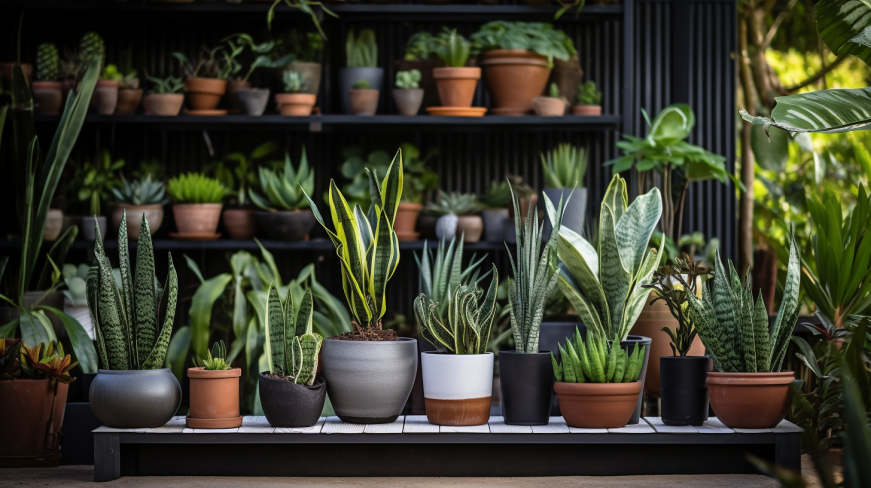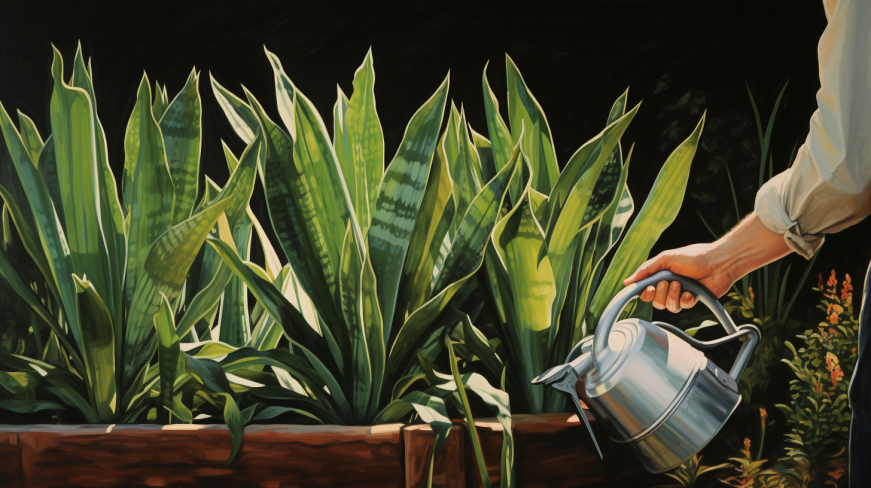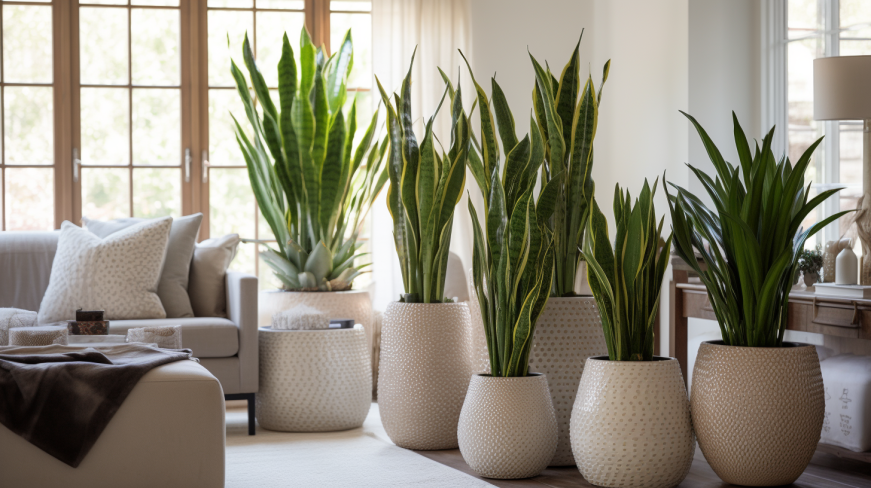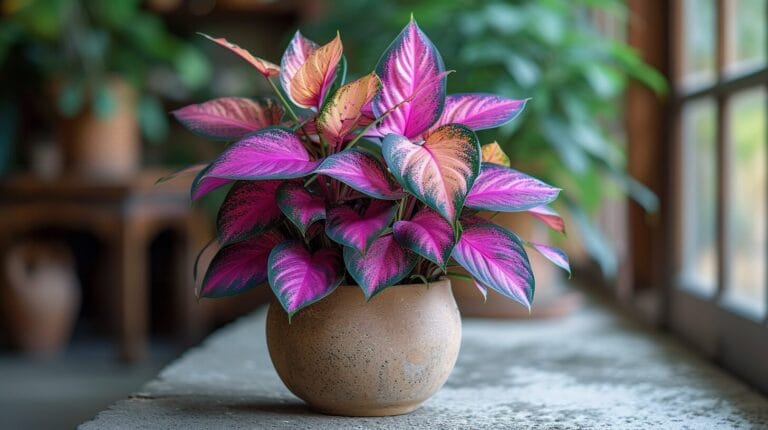Today, I want to express my admiration for snake plants, especially as hedges. By incorporating a Snake Plant Hedge within your home decor, you bring in a unique and flexible aspect to these stunning plants in your living space.
If you’re seeking an unusual, minimal upkeep addition to your green space, you’ve hit the jackpot. I’ll guide you through selecting, planting, and caring for your snake plant hedge.
We’ll also explore how to bring them indoors. Think of this as your crash course to mastering the art of snake plant hedges. Let’s get our hands dirty!
Key Takeaways
- They come in different varieties with various characteristics, such as tall and vertical growth, yellow edges, or dark green leaves with golden edges.
- They have air-purifying properties, absorbing toxins from the air and converting them into harmless substances, thus improving In-house air quality.
- When selecting and purchasing it, consider factors like size, growth rate, and lighting requirements. It is recommended to buy from trusted sources or propagate them yourself.
- Before purchasing, check for signs of health, such as firm green leaves, strong roots, and the absence of pests. Also, choose a pot with drain holes for proper water management.
Understanding the Unique Attributes of Different Varieties of Snake Plants

Let’s look at the unique attributes of different types of snake plants. We’ll start by exploring the key features of popular varieties like the Sansevieria Trifasciata and Laurentii and discuss their purification of air properties. Also, we’ll consider the ‘Black Gold’ variety as a potential candidate for outdoor hedges.
Highlighting Key Features of Popular Snake Plant Varieties Such as Sansevieria Trifasciata and Laurentii
I will delve into the unique features of popular snake plant varieties, particularly the Sansevieria Trifasciata and Laurentii. These varieties are a favorite among plant enthusiasts for their distinct attributes that set them apart from other plant varieties.
- Sansevieria Trifasciata: This variety is known for its tall, vertical growth and dark leafy greens marked with light green bands. It’s loved for its air-purifying qualities and low-maintenance nature. The cylindrical leaves that can grow up to 2-4 feet in height make it a striking addition to any room.
This slow-growing succulent is a perfect choice for those looking to add a touch of green to their homes without too much effort. It can thrive in various light conditions, from full sun to low-lying light, and adapt to different environments. - Laurentii: Characterized by its yellow edges, the Laurentii adds color to any space. It’s equally as hassle-free as the Trifasciata but offers a slightly more vibrant look.
This variegated plant can reach a height of 2-4 feet and has sharp, sword-shaped leaves that can grow up to 14 inches long. The striking contrast between its light and dark leafy greens and the yellow margins makes it a beautiful addition to any room.
These are just two of the many plant varieties that are popular due to their key features. Mastering their care will undoubtedly pay off in a thriving In-house garden.
Whether you place them on a windowsill, bedside table, or planter, these plants can be grown in well-draining soil and don’t require much water. Suppose you want to expand your snake plant collection. In that case, you can also propagate them by separating the rhizome and planting them in separate pots.
So, whether you’re a seasoned plant enthusiast or a newcomer to the world of succulents and cacti, these varieties are excellent choices for bringing a touch of nature into your home.
Discussing the Air-Purifying Properties of Snake Plants
Often, I marvel at its ability to purify air, and it’s no secret that this feature is a significant reason why they’re so popular. They have a knack for absorbing harmful toxins, including benzene, that can accumulate in In-house air. They convert these toxins into harmless substances, thereby enhancing the quality of your air.
Its air-purifying properties aren’t just limited to benzene. These resilient plants also tackle a range of other In-house pollutants, making them an ideal choice for gardening. It’s incredible how these plants not only add aesthetic appeal but also actively contribute to a healthier living environment.
The ‘Black Gold’ Variety as a Candidate for Outdoor Hedges
While there are numerous types of snake plants, the ‘Black Gold’ variety holds its unique charm and makes it a superb candidate for outdoor hedges. This variety has distinct features that set it apart and make it an excellent choice.
Here are some reasons to consider the ‘Black Gold’ variety:
- Its striking contrast: The dark green leaves with golden edges make it a visually appealing addition to any outdoor space.
- Its hardiness: This variety can withstand weather conditions, making it perfect for outdoor hedges.
- Its size: It’s larger than most, providing a robust, dense hedge.
- Its growth habit: It grows upright, creating a neat, tidy hedge without much effort.
- Its maintenance: It doesn’t require much care, making it an ideal candidate for those with a busy lifestyle.
Preparing for the Planting: Tips on Selection and Purchase of Snake Plants

Before I pick out a snake plant, I always think about its specific needs like size, growth rate, and lighting requirements.
I’ve found them at various sources, including online stores and local nurseries, or even through propagation.
It’s also essential for me to check the plant’s health before I buy it to ensure it’s off to a great start.
Considering Factors Like Size, Growth Rate, and Lighting Requirements Before Selecting a Variety
I always consider factors like size, growth rate, and lighting requirements when selecting various snake plants for my hedge. It’s crucial to consider the type that suits your needs and environment.
Here are some tips I’ve found helpful:
- Assess the growth rate of each plant type. Some grow slowly, while others can quickly take over your space.
- Consider the size of the mature plant. It should complement, not overwhelm, your hedge area.
- Check the lighting requirements. Some thrive in low light, others need plenty of sun.
- Think about where you’ll place the plant. Is it spacious enough for the variety you’re selecting?
- Always purchase from a trustworthy nursery. They can provide valuable advice and healthy specimens.
Places to Purchase Snake Plants: Online Stores, Local Nurseries, or Propagation
There’s a variety of places you can purchase snake plants for your hedge, such as online stores, local nurseries, or even through propagation.
Online stores are my go-to for convenience. A quick search for ‘sansevieria’ will yield a plethora of options.
However, local nurseries should be noticed. They offer the advantage of seeing the plant before purchase and, potentially, a wider variety of mature plants.
If you’re feeling adventurous, you could propagate your plants. It’s a cost-effective method, and watching a tiny cutting grow into a full plant hedge is incredibly rewarding.
Regardless of the method, remember to choose healthy plants or cuttings to ensure your hedge thrives.
Checking the Health of the Plant Before Making a Purchase
It’s crucial to examine at least five key health indicators in a snake plant before investing your money and time in it. As a new plant owner, you should check the plant’s health to ensure it thrives as an indoor plant.
Here’s what you should look for:
- Firm green leaves: The plant is well-hydrated and healthy.
- No yellow or brown spots: Indicates no disease or nutrient deficiency.
- Strong roots: A sign of a healthy houseplant.
- No pests: Check under leaves and along the stem.
- Sturdy pot with drain holes: This ensures proper water management.
This way, you’ll not only get a healthy plant but also master its care.
Best Practices for Transplanting and Creating the Snake Plant Hedge

Let’s discuss the best practices for transferring and creating a snake plant hedge.
First, we’ll look at how to prepare the ground and arrange the plants for optimal growth. We’ll also share expert tips on transferring snake plants and creating a visually pleasing layout for your hedge.
Preparing the Ground and Arranging the Snake Plants for Optimal Growth
I will guide you through preparing the ground and arranging your plants for the best possible growth outcomes. The key to optimal growth is ensuring the ground is well-prepared, and the plants are well-arranged.
Here’s a simple step-by-step guide:
- Choose a location with indirect sunlight for your plant.
- Start by preparing the ground; remove any weeds and debris.
- Enrich the soil with compost for nutrient supply.
- Ensure your soil is well-draining to prevent waterlogging.
- Arrange the plants at least 12 inches apart for ample growth space.
Expert Tips on Transplanting Snake Plants to Ensure Successful Transfer
My gardener’s intuition says transferring is easier than you might think. Still, you’ve got to take a few critical steps to ensure their survival.
Firstly, always repot in fresh, well-draining potting soil to give your Trifasciata or Dracaena the best start in its new home. When removing the plant from its old pot, be gentle to avoid damaging the root system. Keep as much of the original potting soil around the roots as possible to reduce shock during transferring.
Using a sharp knife, carefully separate the rosette from the main plant to create new snake plants if desired. Bowstring hemp can also be used for this purpose.
Lastly, after transferring plants, wait to water them. Give them a few days to adjust to their new environment. This can be particularly important when the plant is large, perhaps several inches tall.
Trust me, as an experienced gardener, these tips will help you create a thriving plant.
Creating a Visually Pleasing Layout for the Hedge
In creating a visually appealing snake plant hedge, it’s crucial to carefully plan your garden layout, ensuring balance, symmetry, and eye-catching aesthetics. The easy-to-grow nature of these plants can be leveraged to create a visually pleasing layout with minimal effort.
Here are a few best practices:
- Ensure the plant hedge is placed in a location with adequate sunlight.
- Maintain a consistent planting pattern for symmetry.
- Allow sufficient space for the plants to grow and thrive.
- Incorporate other low-maintenance plants to add diversity and visual interest.
- Regularly prune the hedge to maintain its desired shape and size.
These steps provide a roadmap to creating a low-maintenance, easy-to-grow, visually pleasing plant. A well-planned layout can significantly enhance the appeal of your garden.
You can also try DIY Cement Projects For The Garden to beautify your outdoor space more.
Care and Maintenance of Your Snake Plant Hedge

Now, let’s talk about how to take care of your snake plant hedge. We’ll cover everything from the proper watering schedule to prevent overhydration to the best fertilizing practices to meet their nutrient needs.
We’ll also touch on how to deal with common pests and diseases that could trouble your Sansevieria varieties.
Watering Schedule and Techniques to Avoid Overhydration
I’ll guide you through the proper watering schedule and techniques for your snake plant hedge to avoid overhydration. The key is to allow the soil to dry out between waterings, as they are susceptible to root rot if overwatered.
Consider these steps:
- Water your plant profoundly but infrequently.
- Allow the soil to dry out completely between waterings.
- Use pots with drainage holes to prevent water logging.
- Monitor your plant’s needs; it may require less water in cooler months.
- Avoid watering directly into the center of the plant.
Nutrient Needs and Best Fertilizing Practices For Snake Plants
Surprisingly, snake plants don’t need much fertilizer, but they do appreciate a nutrient boost during their growing seasons. As part of your plant care and maintenance, understanding their nutrient needs is crucial.
A slow-release fertilizer added to your potting mix in the spring provides the necessary nutrients for growth. The best fertilizing practices for them also involve reducing fertilization during winter, when growth is slow. Remember, less is more with these minimal upkeep plants. Over-fertilizing can cause more harm than good.
Dealing With Common Pests and Diseases of Sansevieria Varieties
Even though snake plants are resilient, I must address how to deal with common pests and diseases that can impact different Sansevieria varieties. Your plant hedge can still suffer from root rot, mealybugs, and spider mites.
Mastery of these problems involves:
- Regularly check your plants for signs of pests or disease.
- Ensuring your plants get the right amount of water, as overwatering can lead to root rot.
- Isolating any infected plants to prevent the spread of pests.
- Using organic insecticides for dealing with pests.
- Regularly cleaning your plants to prevent dust build-up, which attracts pests.
Using Snake Plants Inside Your Home: From Hedge to House

Now, let’s shift our focus from the garden to the inside of your home. I will share a few key benefits of bringing your snake plant indoors and guide you through repotting from your outdoor hedge to an indoor pot.
We’ll also talk about how you can use them as a unique design element in various rooms in your home.
Benefits Of Bringing Your Snake Plant Indoors
I’ve discovered five significant benefits of bringing your snake plant indoors from its usual hedge position.
- Air Purification: They are known to remove harmful toxins such as formaldehyde and xylene from the air, improving indoor air quality.
- Non-Toxic: Despite its intimidating name, they aren’t toxic to humans and pets, making them a safe addition to your home.
- Low Maintenance: Unlike other houseplants, they require minimal care, which makes them perfect for individuals with a busy schedule.
- Aesthetic Appeal: They have a unique aesthetic that can enhance the decor of any room.
- Increases Humidity: They release moisture into the air, which can increase indoor humidity, which is beneficial for dry climates or during winter.
Indeed, the benefits of bringing your plant indoors are considerable.
How to Successfully Re-pot a Snake Plant From Your Hedge to a Pot Inside Your Home
Let’s delve into how you can successfully re-pot a snake plant from your outdoor hedge to a cozy pot inside your home. Firstly, you’ll need to carefully extract your plant from the hedge, keeping the root structure intact.
Here’s a simple table to guide you through this process:
| Step | Action |
| 1 | Extract from hedge |
| 2 | Prepare your pot with soil mix |
| 3 | Re-pot into the new pot |
| 4 | Position the plant in a suitable location inside your home |
| 5 | Nurture the plant with necessary watering and sunlight |
Using Snake Plants as a Design Element in Various Rooms in the House
Incorporating snake plants as a design element in various rooms is a fabulous idea, and it’s not just about aesthetics but also about their purification of air qualities. I’ve used them in my house, using them as a natural green hedge, and I’ve loved the difference they’ve made.
Here’s how you can, too:
- Place them in a larger pot to allow growth and maintain balance.
- They love indirect light, so position them near windows but not in direct sunlight.
- Complement them with other forms of greenery for a lush, indoor garden feel.
- Use its hedges as room dividers or to define spaces.
- Experiment with different pot designs to match your interior decor.
With these tips, you can easily use them as a design element in various rooms in your house.
Frequently Asked Questions
What Are the Potential Health Benefits of Having a Snake Plant Hedge?
Having this type of hedge can improve your home’s air quality. It’s known to absorb toxins like formaldehyde and benzene. Plus, it releases oxygen at night, which could enhance your sleep quality.
How Can Snake Plants Contribute to Improving the Overall Aesthetics of My Garden?
In my experience, snake plants can dramatically boost your garden’s aesthetics. They’re striking with their tall, upright leaves, adding height and contrast. Plus, they’re evergreen, ensuring a lush look all year round.
Can Snake Plants Survive in Areas With Extreme Weather Conditions?
Snake plants can survive extreme weather conditions. They’re tough and drought-resistant, so they’ll handle heat well. For cold climates, though, they’re not frost-tolerant and will need protection or indoor placement.
What Are the Potential Pests or Diseases That Can Affect the Snake Plant Hedge?
In my experience, spider mites, mealybugs, and aphids can infest snake plants. Root rot is also a common disease, often due to overwatering. Regular inspection and proper care can prevent these issues.
Can Snake Plants Be Used for Any Medicinal Purposes?
I’ve found that snake plants have some medicinal uses. They’re known to purify air by removing toxins, potentially improving health. However, they’re not typically used in traditional medicine practices.
Conclusion
In wrapping up, creating a snake plant hedge is more straightforward than it might sound. With the proper knowledge of the plant’s varieties, adequate preparation, and proper care, you’ll have a thriving green barrier in no time.
The ‘Laurentii’ variety of snake plants, also known as mother-in-law’s tongue, is an excellent choice, with its striking banded leaves that can add an elegant touch to any space. And remember, these plants aren’t just for outdoors. They can liven up your indoors, too! So why not give it a shot?
It’s a rewarding, eco-friendly project that’s worth your while. Whether you choose to plant the nest snake plant or the black gold variety, you’ll find that these leaves grow beautifully, and their low-maintenance nature makes them perfect for one home and another.
And remember, these plants aren’t just for outdoors. They can liven up your indoors, too! So why not give it a shot? It’s a rewarding, eco-friendly project that’s worth your while.







